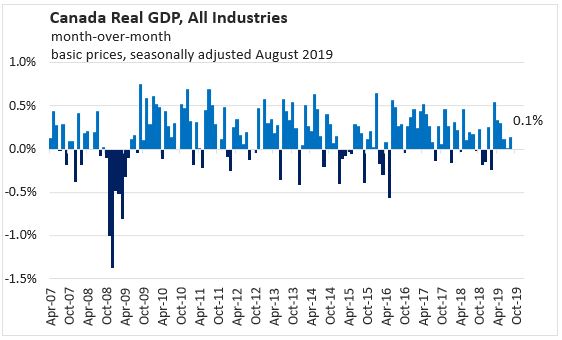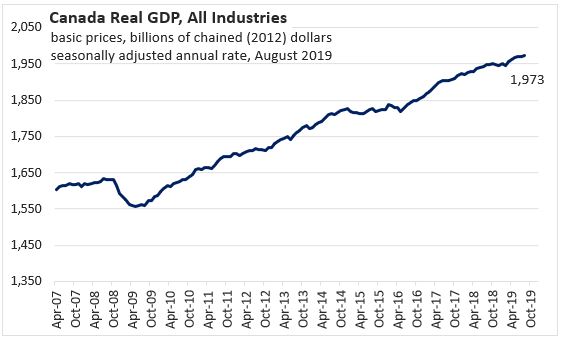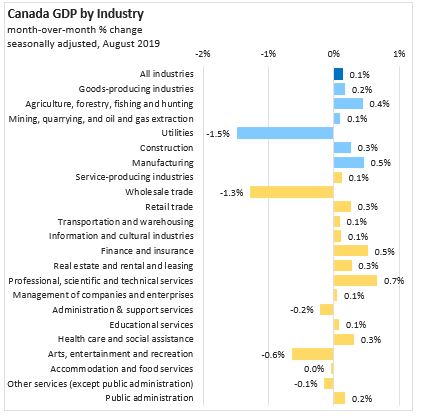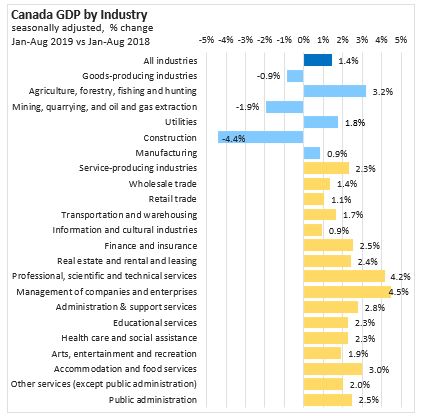The Economics and Statistics Division maintains archives of previous publications for accountability purposes, but makes no updates to keep these documents current with the latest data revisions from Statistics Canada. As a result, information in older documents may not be accurate. Please exercise caution when referring to older documents. For the latest information and historical data, please contact the individual listed to the right.
<--- Return to Archive
For additional information relating to this article, please contact:
October 31, 2019CANADA GDP BY INDUSTRY, AUGUST 2019 
Real GDP in Canada increased 0.1 per cent in August following no change in July and growth the previous four months. Goods-producing industries increased 0.2 per cent after two months of decline. Service-producing industries were up for the sixth consecutive month with a 0.1 per cent gain. Compared to August 2018, the Canadian economy is 1.6 per cent larger with an annualized value of $1,973 billion (chained 2012 dollars) in August 2019.

The manufacturing sector grew 0.5 per cent with a rise in durable (+1.0%) and a decline in non-durable (-0.2%). Durable manufacturing expanded in fabricated metal products, non-metallic mineral product manufacturing due to higher international demand. Transportation equipment grew for the fourth consecutive month with growth in aerospace products, other transportation equipment and motor vehicle body and trailer manufacturing. Among non-durables the decline was led by 1.5 per cent decrease in food manufacturing.
Construction was up for the third time in the past four months - residential construction grew with new dwelling construction and non-residential construction grew with activity in commercial, industrial and public sectors.
Oil and gas extraction was down for the third time in the past four months due in part to maintenance shutdowns. Mining and quarrying was down 0.2 per cent with declines in metal ore (except iron ore mining) and coal mining.
Professional services has grown every month since February 2018, activity was up 0.7 per cent in August. Most of the subsectors were up led by computer systems design and related services. The legal, accounting and related service subsector grew 0.8 per cent in part due to increase activity at offices of real estate agents and brokers.
The Finance and insurance sector grew for the fourth month in a row as S&P/TSX Composite Index volatility contributed to the highest volume of transactions since 2012. Wholesale activity had a broad-based decline of 1.3 per cent. Retail trade grew 0.3 per cent from demand at gasoline stations and sectors associated with back-to-school shopping.

Comparing the size of the Canadian economy in January-August 2019 with January-August 2018, there has been a 1.4 per cent increase due to higher service sector output (+2.3 per cent) while the goods-producing sector declined by 0.9 per cent. Higher levels of activity in agriculture, forestry, fishing and hunting, utilities and manufacturing only partially offset the lower levels of activity in mining, quarrying, and oil and gas extraction and construction. Service sector output is higher across all subsectors with the largest increases in management of companies, professional, scientific and technical services, and accommodations and food services subsectors.

Source: Statistics Canada.
Table 36-10-0434-01 Gross domestic product (GDP) at basic prices, by industry, monthly (x 1,000,000)
<--- Return to Archive